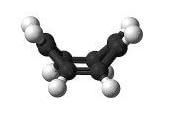IIT JAM Exam > IIT JAM Questions > Why non aromatic compounds are more stable th...
Start Learning for Free
Why non aromatic compounds are more stable than anti aromatic?
Verified Answer
Why non aromatic compounds are more stable than anti aromatic?
Ans.
Anti aromatic : planar , conjugated carbocyclic polyenes that are less stable than their open-chain analogues having 4nπ
electrons in complete delocalisation (eq 4,6 etc) are called anti-aromatic species.
Non Aromatic -completely conjugated carbocylic polyenes whos stability is comparable to thier open-chain analouges are called non armoatic.
In Conjugated-pi ring systems of N atoms, you typically have a single low energy orbital and then paired (degenerate) energy levels until you have N orbitals totalThis has to do with the number of nodes in the conjugated pi system, and the number of ways you can lay them out with N atoms.

Now, when you add in electrons you add two electrons per orbital, so your 4n+2 electrons fill 2n+1 orbitals -- the single low energy orbital and then n complete sets of degenerate pairs.

If you only have 4n electrons, you can fill the single low energy orbital, then 2(n-1) complete sets of degenerate pairs ... but with two "extra" electrons which aren’t paired up . This allows those two electrons to "spread" out between the pair of equal-energy orbitals. Those unfilled/partially filled orbitals mean that the anti-aromatic compound is quite reactive.

The other issue is that "stability" is not an absolute property. Stability is always in reference to some other state. The typical anti-aromatic systems you'll encounter tend to have those frontier orbitals as non-bonding or anti-bonding orbitals, meaning the electrons in the orbitals aren't really contributing to the molecular stability. Generally, if you build the energy level diagrams for alternate systems (e.g. a bent ring where you don't get localization) you'll find that - while the lowest energy orbital isn't as low energy as in the ring-conjugated system - the sum of the energies across all orbitals is indeed lower. And it's the total energy of the system which is optimized. (For example, in cyclobutadiene the ring-conjugated form would have two electrons in a low-energy bonding orbital and two in non-bonding orbitals. In contrast, linear butadiene bonding orbitals are not as low energy as for the ring-conjugated cyclo form, but there's two of them. And the sum of the energies from two linear bonding orbitals is lower than what you get from a single cyclo bonding orbital.)
 This question is part of UPSC exam. View all IIT JAM courses
This question is part of UPSC exam. View all IIT JAM courses
Most Upvoted Answer
Why non aromatic compounds are more stable than anti aromatic?
Introduction:
Aromatic compounds are known for their exceptional stability due to their unique electronic structure, which is characterized by a conjugated ring of π electrons. On the other hand, non-aromatic compounds do not possess this special stability. In fact, non-aromatic compounds are generally more stable than anti-aromatic compounds. This can be attributed to several factors that influence the stability of a compound.
Electronic Structure:
- Aromatic compounds have a fully conjugated ring of π electrons, which results in a delocalization of electron density throughout the molecule. This delocalization lowers the overall energy of the compound, making it more stable.
- Non-aromatic compounds lack a fully conjugated ring of π electrons, but they still have some degree of delocalization, although it is not as extensive as in aromatic compounds. This partial delocalization contributes to the stability of non-aromatic compounds.
- Anti-aromatic compounds, on the other hand, have a fully conjugated ring of π electrons, like aromatic compounds, but with a key difference. In anti-aromatic compounds, the delocalized electrons are arranged in a way that leads to an unfavorable cyclic electron flow. This results in increased electron density and destabilization of the compound.
Hückel's Rule:
- Hückel's rule states that aromatic compounds must have a planar, cyclic, and fully conjugated system of π electrons, with 4n+2 π electrons, where n is an integer. This rule explains the exceptional stability of aromatic compounds.
- Non-aromatic compounds do not fulfill the requirements of Hückel's rule, but they still have some degree of conjugation, which contributes to their stability.
- Anti-aromatic compounds also follow Hückel's rule, but with 4n π electrons. The cyclic electron flow in anti-aromatic compounds leads to a destabilizing effect, making them less stable than non-aromatic compounds.
Ring Strain:
- Non-aromatic compounds often have fewer ring strains compared to anti-aromatic compounds. Ring strain arises from unfavorable interactions between atoms in a ring, leading to increased energy and decreased stability.
- The cyclic electron flow in anti-aromatic compounds creates additional ring strain due to the repulsion between adjacent electrons. This further destabilizes the compound and makes it less stable than non-aromatic compounds.
Conclusion:
In summary, non-aromatic compounds are more stable than anti-aromatic compounds due to their lack of unfavorable cyclic electron flow, reduced ring strain, and partial delocalization of electrons. The exceptional stability of aromatic compounds, on the other hand, arises from their fully conjugated ring of π electrons and adherence to Hückel's rule. Understanding the electronic structure and factors influencing stability allows us to predict and explain the relative stability of different compounds.
Aromatic compounds are known for their exceptional stability due to their unique electronic structure, which is characterized by a conjugated ring of π electrons. On the other hand, non-aromatic compounds do not possess this special stability. In fact, non-aromatic compounds are generally more stable than anti-aromatic compounds. This can be attributed to several factors that influence the stability of a compound.
Electronic Structure:
- Aromatic compounds have a fully conjugated ring of π electrons, which results in a delocalization of electron density throughout the molecule. This delocalization lowers the overall energy of the compound, making it more stable.
- Non-aromatic compounds lack a fully conjugated ring of π electrons, but they still have some degree of delocalization, although it is not as extensive as in aromatic compounds. This partial delocalization contributes to the stability of non-aromatic compounds.
- Anti-aromatic compounds, on the other hand, have a fully conjugated ring of π electrons, like aromatic compounds, but with a key difference. In anti-aromatic compounds, the delocalized electrons are arranged in a way that leads to an unfavorable cyclic electron flow. This results in increased electron density and destabilization of the compound.
Hückel's Rule:
- Hückel's rule states that aromatic compounds must have a planar, cyclic, and fully conjugated system of π electrons, with 4n+2 π electrons, where n is an integer. This rule explains the exceptional stability of aromatic compounds.
- Non-aromatic compounds do not fulfill the requirements of Hückel's rule, but they still have some degree of conjugation, which contributes to their stability.
- Anti-aromatic compounds also follow Hückel's rule, but with 4n π electrons. The cyclic electron flow in anti-aromatic compounds leads to a destabilizing effect, making them less stable than non-aromatic compounds.
Ring Strain:
- Non-aromatic compounds often have fewer ring strains compared to anti-aromatic compounds. Ring strain arises from unfavorable interactions between atoms in a ring, leading to increased energy and decreased stability.
- The cyclic electron flow in anti-aromatic compounds creates additional ring strain due to the repulsion between adjacent electrons. This further destabilizes the compound and makes it less stable than non-aromatic compounds.
Conclusion:
In summary, non-aromatic compounds are more stable than anti-aromatic compounds due to their lack of unfavorable cyclic electron flow, reduced ring strain, and partial delocalization of electrons. The exceptional stability of aromatic compounds, on the other hand, arises from their fully conjugated ring of π electrons and adherence to Hückel's rule. Understanding the electronic structure and factors influencing stability allows us to predict and explain the relative stability of different compounds.

|
Explore Courses for IIT JAM exam
|

|
Similar IIT JAM Doubts
Why non aromatic compounds are more stable than anti aromatic?
Question Description
Why non aromatic compounds are more stable than anti aromatic? for IIT JAM 2025 is part of IIT JAM preparation. The Question and answers have been prepared according to the IIT JAM exam syllabus. Information about Why non aromatic compounds are more stable than anti aromatic? covers all topics & solutions for IIT JAM 2025 Exam. Find important definitions, questions, meanings, examples, exercises and tests below for Why non aromatic compounds are more stable than anti aromatic?.
Why non aromatic compounds are more stable than anti aromatic? for IIT JAM 2025 is part of IIT JAM preparation. The Question and answers have been prepared according to the IIT JAM exam syllabus. Information about Why non aromatic compounds are more stable than anti aromatic? covers all topics & solutions for IIT JAM 2025 Exam. Find important definitions, questions, meanings, examples, exercises and tests below for Why non aromatic compounds are more stable than anti aromatic?.
Solutions for Why non aromatic compounds are more stable than anti aromatic? in English & in Hindi are available as part of our courses for IIT JAM.
Download more important topics, notes, lectures and mock test series for IIT JAM Exam by signing up for free.
Here you can find the meaning of Why non aromatic compounds are more stable than anti aromatic? defined & explained in the simplest way possible. Besides giving the explanation of
Why non aromatic compounds are more stable than anti aromatic?, a detailed solution for Why non aromatic compounds are more stable than anti aromatic? has been provided alongside types of Why non aromatic compounds are more stable than anti aromatic? theory, EduRev gives you an
ample number of questions to practice Why non aromatic compounds are more stable than anti aromatic? tests, examples and also practice IIT JAM tests.

|
Explore Courses for IIT JAM exam
|

|
Signup for Free!
Signup to see your scores go up within 7 days! Learn & Practice with 1000+ FREE Notes, Videos & Tests.



















